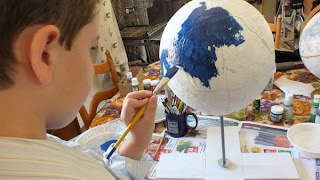O arrived early, which was a good thing as he has the painting of his earth model to do.
So with soft nature and flute songs our day begins.
08.29.13
Week 2
Earth and Moon
Paint / Finish Earth Model
Papa made the stand, I will be adding lakes to the continents and a protective coat to the finished model.
Wobbler Experiment
pg 12 Janice Van Cleave's "Earth Science for Every Kid"
This experiment is designed to demonstrate how the composition of the earth affects its motion.
We used 1 hard boiled and 1 raw egg for this experiment.
I would suggest caution for over exuberant children who want to spin fast.
It can be messy. :)
(We found that it was best to spin the eggs on their bottoms, not there sides for the best results)
The hard egg spun quite well whereas the raw egg did not spin at all, just kind of flopped.
The material inside each egg affects how well it spun just as the Earth's inside affect its rotation.
Parts of the Earths mantle and outer core are liquid and part are solid. The liquid part allows for some wobbling just like the raw egg, but the solid part give the earth stability in rotations. This makes the earth's wobbling very slight.
| Spin!! or not. |
Day and Night Experiment
pg 14 Janice Van Cleave's "Earth Science for Every Kid"
Using a flashlight, dark shirt and mirror we created an experiment that would determine the cause of the day and night cycle.
In a dark room we placed the flashlight, which represented the sun, on a ledge and O, who represented the Earth, turned slowly holding the mirror, which represented the moon.
At a certain point in the turn the light from the "sun" reflected off of the "moon" onto the "Earth".
While the "sun" was always shining on the "Earth", the "moon" only shone at times just as as the real Earth turns east and the light from the sun travels around the rotating earth creating daytime and nighttime.
The night is very dark when the moon does not reflect the suns light but even when it does it is not as bright as the sun.
(See the two reflections on O's shirt; one bright on the left, one subdued on the right)
Read Usborne First Encyclopedia of Our World pg 10 - 11 Earth from Space
Narration Sheet
Lunch - This week he chose a PBJ. I was surprised as he usually likes the "smooshy" (sunny side up) egg sandwich. I asked him if he wanted milk, water or tea and he said, "your sweet milk".
I could not remember what that meant so after some conversation I determined milk with cream. Last year I had mixed it for him and told him how, when I was younger we bought our milk from a farmer; pastuerized, not homogenized. We had cream in our milk that separated every day and had to be mixed back into the milk or removed.
I took a little sip, ahhhh, memories.
Read UOW pg 12 -13 Day and Night
Narration Sheet - Recording what he learned about Earth from Space and Day and Night
Vocabulary word of the week - Solar Eclipse
The time when the moon blocks the sun
Test of the week
Next Week we will study the rain cycle and seasonal changes.
O's Earth will be mounted and dry enough to take home.













No comments:
Post a Comment